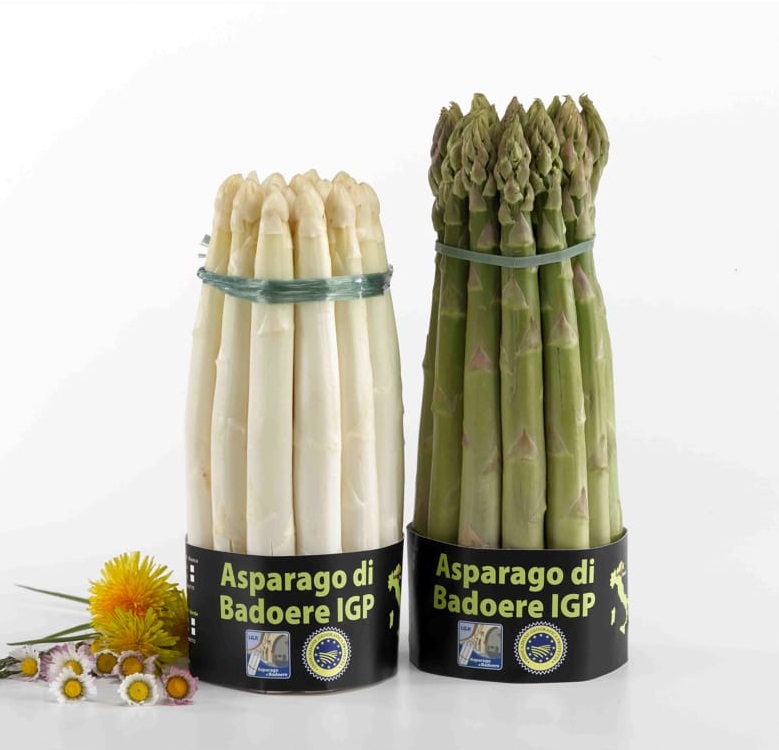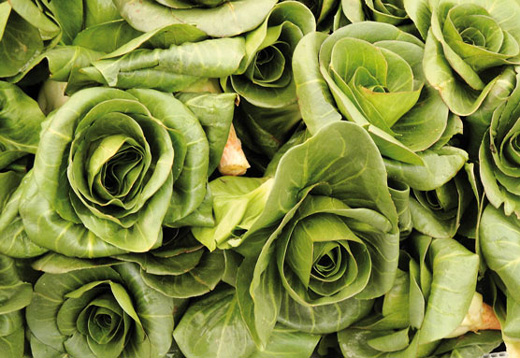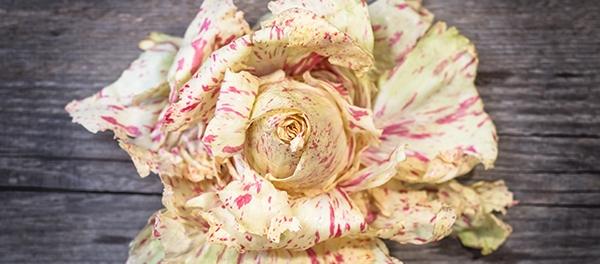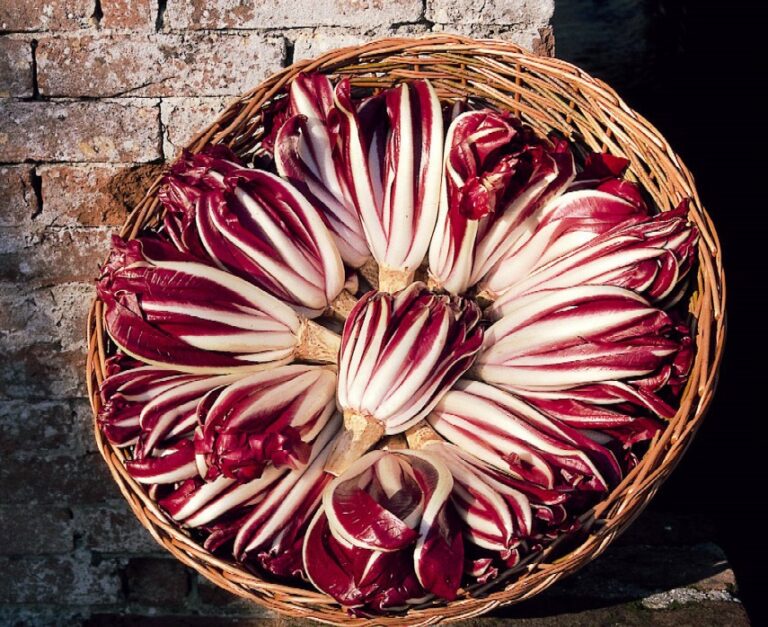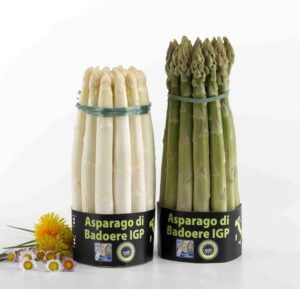
Asparagus from Badoere
Asparago di Badoere PGI (protected geographical indication). The origin seems to date back to the Roman conquest. The production and packaging area of ”Asparago di Badoere” Igp – in the white and green types – includes (provinces of Padua, Treviso and Venice) the municipalities Piombino Dese, Trebaseleghe, Casale sul Sile, Casier, Istrana, Mogliano, Morgano, Paese, Preganziol, Quinto, Resana, Treviso, Vedelago, Zero Branco and Scorzé. Asparagus from Badoere IGP is officially on the list of European agri-food products of excellence.
History of asparagus
Asparagus was cultivated and used in the Mediterranean by the Egyptians and in Asia Minor 2000 years ago, as well as in Spain. The Romans as early as 200 BC they had manuals in which their cultivation is meticulously expounded. Asparagus was in fact mentioned by Theophrastus, Cato, Pliny and Apicius; in particular, the latter two accurately described not only the cultivation method, but also the preparation method.
The Roman emperors liked asparagus so much, that, for example, it seems that they had built special ships to pick them up, ships that had as their name precisely that of asparagus (“asparagus”). France, and then, in the sixteenth century, reaching the peak of popularity also in England; only later was it introduced in North America. Native Americans dried asparagus for later medicinal uses. The term asparagus derives from the Latin asparagus, which means sprout. The Romans gave this name to the asparagus plant for two reasons: firstly because the edible part is only the apical part of the shoot, secondly because it was believed that asparagus possessed beneficial healing properties capable of regenerating the human body and restoring it new life.
In Veneto, the origin seems to date back to the conquest by the Romans of the Venetian lands, reaching the present day thanks to the loving traditions perpetuated in the monasteries.
The specialized cultivation of the plant, however, is quite recent, having developed after the last world war in conjunction with the transformation of sharecropping and with the abandonment of the silkworm breeding that made available, in the spring season (period in the which, previously, the breeding of the worm required a considerable commitment), a labor that otherwise would not have found employment. From a documentary point of view, there are countless sources that include the “Asparagus of Badoere” as one of the finest local products in the Veneto region.
It is also worth remembering that the importance of Badoere in the production of asparagus, at the provincial level, prompted the municipal administration of Morgano to organize the “First Provincial Asparagus Exhibition” since 1968, a tradition that is handed down even today. An activity that is strongly rooted in the culture of the inhabitants of the area interested in this production, where cultivation techniques have been handed down from generation to generation.
The particular combination of production factors, such as manual skills and craftsmanship, together with the pedoclimatic factors of the delimited area, allows this type of production to differentiate itself decisively from the entire sector of reference. The great diffusion and notoriety of the product, achieved thanks to the implementation of various promotional initiatives, demonstrate the great reputation of the “Asparagus of Badoere”.
Production area
The production and packaging area of the “Asparagus of Badoere” I.G.P. includes within the provinces of Padua, Treviso and Venice, the entire territory of the following municipalities:
Province of Padua: Piombino Dese; Trebaseleghe;
Province of Treviso: Casale sul Sile; Casier; Istrana; Mogliano Veneto; Morgano;
Country; Preganziol; Fifth of Treviso; Resana; Treviso; Vedelago; Zero Branco;
Province of Venice: Scorzè.
The area involved in the trade of Badoere Asparagus is currently mainly identified in the three Veneto provinces of Treviso, Padua and Venice, but in recent years there has been a constant expansion of the sales area to the entire Veneto region and in the northern Italy, in particular in Lombardy and Emilia Romagna.
Gastronomy
The delicate and fine flavor of the white asparagus shoots is an irresistible delicacy. Asparagus must be cooked fresh to fully savor its gastronomic value and delicate fragrance. For a correct conservation it is advisable to wrap them in a damp cloth and place them in the refrigerator in the vegetable department; they can be kept for a few days.
THE RECIPES OF TRADITION
BOILED BADOERE ASPARAGUS
Thoroughly clean and wash the Badoere Asparagus. Bound in bunches, cook them in boiling salted water, standing with the tips out of the water, in a tall, covered pot. Remove from the water while still hot and cooked al dente, drain and immediately bring them to the table (250 grams of Badoere Asparagus per person). To be served with hard-boiled eggs and seasoned with pepper, salt and extra virgin olive oil.
RISOTTO WITH ASPARAGUS FROM BADOERE
Fry the chopped onion, add the chopped Badoere asparagus and leave to flavor for five minutes. Add the wine and let it evaporate. Add the rice and let it toast. Cook by adding the boiling broth a little at a time. At the end whisk with butter and grated cheese.
Doses for 4 people: 300g of Badoere Asparagus (better if spikes), 350g of rice, 50g of butter, 1 onion, 1/2 glass of white wine, 50g of grated cheese, salt.
GRILLED GREEN ASPARAGUS FROM BADOERE
Grease the Badoere green asparagus thoroughly, salt and pepper them, then place them on the hot grill to roast. Then season them with a drizzle of raw oil and serve hot. Doses for 4 people: 1000 gr of green asparagus from Badoere, olive oil, salt and pepper.
Presentation
When released for consumption, the “Asparagus of Badoere” I.G.P. . for both types it must be: Whole; Healthy; Free from damage caused by inadequate washing; Clean; Fresh in appearance and color; Free of parasites; Free from damage caused by parasites; Free of dents; Free of abnormal external moisture; Free of foreign smell and / or taste; Crisp; Not empty; Not peeled. The cut at the base must be clean and perpendicular to the longitudinal axis, and in particular:
“Asparagus of Badoere” I.G.P. – White
– Extra Category:
Conformation: straight shoot; very tight apex;
Color: white, with possible pinkish shades acquired after the packaging phase;
Flavor: sweet, non-acidic, unsalted, tender, free of fibrousness, slight aroma of fresh legumes and ripe ear of wheat, with barely perceptible bitterness;
Caliber: from 12 to 20 mm; with a maximum difference of 6 mm between the largest and the smallest shoot within the same bunch or package;
Length: Between 14 and 22 cm; with a maximum difference of 1 cm between the shortest and the longest shoot within the same bunch or package.
– Category First:
Conformation: straight shoot; tight apex;
Color: white, with possible pinkish shades acquired after the packaging phase;
Flavor: sweet, non-acidic, unsalted, tender, free of fibrousness, slight aroma of fresh legumes and ripe ear of wheat, with barely perceptible bitterness;
Caliber: 10 to 22 mm; with a maximum difference of 8 mm between the largest and the smallest shoot within the same bunch or package.
Length: between 14 and 22 cm; with a maximum difference of 1 cm between the shortest and the longest shoot within the same bunch or package.
“Asparagus of Badoere” I.G.P. – Green
– Extra Category:
Conformation: straight shoot, with possible slight deviation of the tip, very tight apex;
Color: apical part – intense and brilliant green, with possible violet hues; basal part (not more than 5% of the shoot) – green with purple variations up to white;
Taste: sweet and marked, not acidic, not salty, not bitter, tender, free of fibrousness, persistent fruity and herbaceous aroma;
Caliber: from 12 to 20 mm; with a maximum difference of 6 mm between the largest and the smallest shoot within the same bunch;
Length: Between 18 and 27 cm; with a maximum difference of 1 cm between the shortest and the longest shoot within the same bunch.
– Category First:
Conformation: straight shoot, with possible slight deviation of the tip, tight apex;
Color: apical part – intense and brilliant green, with possible purple hues; basal part (not more than 5% of the shoot) – green with purple variations up to white;
Taste: sweet and marked, not acidic, not salty, not bitter, tender, free of fibrousness, persistent fruity and herbaceous aroma;
Caliber from 8 to 22 mm; with a maximum difference of 8 mm between the largest and the smallest shoot within the same bunch;
Length: Between 16 and 27 cm; with a maximum difference of 1 cm between the shortest and the longest shoot within the same bunch.
Nutritional and dietary aspects
Asparago di Badoere PGI has remarkable dietary properties. It is rich in vitamins and minerals, has proven diuretic and purifying properties, thanks to the high water and fiber content. Like all vegetables, it has a low energy value and is well suited for low-calorie diets, as well as being highly digestible. High is the content of asparagine or aspartic acid and folic acid, which is important for pregnant women.
NUTRITIONAL VALUES OF ASPARAGUS OF BADOERE IGP
WATER% 91.4
PROTEIN Gr x 100 3.6
LIPIDS Gr x 100 0.2
GLUCIDES Gr x 100 3.3
ENERGY Kcal 29
iron mg 1.2
calcium 2.5 mg
phosphorus mg 77
Vitamin A 82 mg

